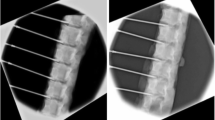Abstract
Plasma energy has been used to provide minimally invasive interventional treatment for spinal problems. However, this procedure has been used for limited indications mainly because of its small resection range. To overcome this problem, we designed the enhanced power plasma device. This device seeks to maximize the resection area by modifying the electrode arrangement and enhancing the maximum electric power. The purpose of this study is to assess the efficiency and safety of this newly designed plasma generator, a device for percutaneous disc decompression. We performed an intradiscal procedure on 7 fresh human cadaver lumbar spine specimens using the enhanced power plasma under C-arm fluoroscopic guidance at various voltages. As a result, the volume of the removed area was proportional to the applied magnitude of the electric power level. In particular, under the high-power level condition after 500 s treatment, nearly the entire nucleus pulposus was eliminated. The generated plasma density also tends to grow along with the given electric power. The highest level of temperature rise did not exceed the level that would lead to degeneration in the collagen tissue of the intervertebral disc. Histopathologic examination also demonstrated that there was no thermal damage to the surrounding neural tissues. In conclusion, we speculate that the concepts of this newly designed enhanced plasma generator could be applied to remove huge disc materials without thermal or structural damage to the adjacent target tissues in future spine clinics.






Similar content being viewed by others
References
Ascher PW, Heppner F. CO2-Laser in neurosurgery. Neurosurg Rev. 1984;7(2):123–33.
Birnbaum K. Percutaneous cervical disc decompression. Surg Radiol Anat. 2009;31(5):379–87.
Fraser RD. Chymopapain for the treatment of intervertebral disc herniation. A preliminary report of a double blind study. Spine (Phila Pa 1976). 1982;7(6):608–12.
Liebler WA. Percutaneous laser disc nucleotomy. Clin Orthop Relat Res. 1995;(310):58–66.
Lesoin F, Autricque A, Clarisse J, Villette L, Jomin M. Automatized percutaneous nucleotomy in lumbar disc pathology. J Chir (Paris). 1989;126(3):185–8.
Nerubay J, Caspi I, Levinkopf M, Tadmor A, Bubis JJ. Percutaneous laser nucleolysis of the intervertebral lumbar disc: an experimental study. Clin Orthop Relat Res. 1997;337:42–4.
Castro WHM, Halm H, Jerosch J, Steinbeck J, Meyer M, Gohlke KH, et al. Long-term changes in the magnetic resonance image after chemonucleolysis. Eur Spine J. 1994;3(4):222–4.
Chen YC, Lee S-H, Saenz Y, Lehman NL. Histologic findings of disc, end plate and neural elements after coblation of nucleus pulposus: an experimental nucleoplasty study. Spine J. 2003;3(6):466–70.
Lee SH, Derby R, Sul D, Hong J, Kim GH, Kang S, et al. Efficacy of a new navigable percutaneous disc decompression device (L’DISQ) in patients with herniated nucleus pulposus related to radicular pain. Pain Med. 2011;12(3):370–6.
Hong YK, Derby R, Wolfer LR, Kim SU, Kang BS, Kim NH, et al. An Assessment of a New Navigatable Percutaneous Disc Decompression device (L’DISQ) through histologic evaluation and Thermo-Mapping in human cadaveric discs. Pain Med (United States). 2012;13(8):1000–3.
Smith L, Garvin PJ, Gesler RM, Jennings RB. Enzyme dissolution of the nucleus pulposus. Nature. 1963;198(4887):1311–2.
Jaikumar S, Kim DH, Kam AC. History of minimally invasive spine surgery. Neurosurgery. 2002;51(suppl_2):2-1.
Belov SV. Use of high-frequency cold plasma ablation technology for electrosurgery with minimized invasiveness. Biomed Eng (NY). 2004;38(2):80.
Bonaldi G, Baruzzi F, Facchinetti A, Fachinetti P, Lunghi S. Plasma radio-frequency–based diskectomy for treatment of cervical herniated nucleus pulposus: feasibility, safety, and preliminary clinical results. Am J Neuroradiol. 2006;27(10):2104–11.
Stalder KR, McMillen DF, Woloszko J. Electrosurgical plasmas. J Phys D Appl Phys. 2005;38(11):1728.
Wall MS, Deng X-H, Torzilli PA, Doty SB, O’Brien SJ, Warren RF. Thermal modification of collagen. J shoulder Elb Surg. 1999;8(4):339–44.
Yoon S-Y, Jang YC, Lee SH, Hong JW, Hong YK, Kim GH. Characteristics of vapor coverage formation on an RF-driven metal electrode to discharge a plasma in saline solution. Plasma Sources Sci Technol. 2012;21(5):055017.
Yoon S-Y, Kim SJ, Hong YK, Lee SH, Kim GH. Characteristics of OH* generation in pin-to-Electrolyte Discharges. IEEE Trans Plasma Sci. 2014;42:2814–15.
Funding
The authors declare that no funds, grants, or other support were received during the preparation of this manuscript.
Author information
Authors and Affiliations
Contributions
This study was supervised by Sangheon Lee. The design and fabrication of enhanced power plasma was carried out by Sung-Young Yoon. Cadaver experiments were conducted by Sangho Sohn and Nack Hwan Kim. Data collection and analysis were performed by Yushin Kim. The first draft of the manuscript was written by Youngki Hong and all authors commented on previous versions of the manuscript. All authors read and approved the final manuscript.
Corresponding author
Ethics declarations
Competing interests
The authors have no relevant financial or non-financial interests to disclose.
Additional information
Publisher’s Note
Springer Nature remains neutral with regard to jurisdictional claims in published maps and institutional affiliations.
Rights and permissions
Springer Nature or its licensor (e.g. a society or other partner) holds exclusive rights to this article under a publishing agreement with the author(s) or other rightsholder(s); author self-archiving of the accepted manuscript version of this article is solely governed by the terms of such publishing agreement and applicable law.
About this article
Cite this article
Hong, Y., Yoon, SY., Sohn, S. et al. Evaluation of the resection efficiency and safety of an enhanced power plasma generator using cadaveric intervertebral discs. Biomed. Eng. Lett. 13, 57–64 (2023). https://doi.org/10.1007/s13534-022-00253-9
Received:
Revised:
Accepted:
Published:
Issue Date:
DOI: https://doi.org/10.1007/s13534-022-00253-9




